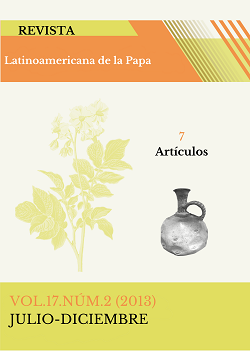Solanum phureja Juz et Buk.: Valuable Source of Genetic Resistance to Potato Late Blight [Phytophthora infestans (Mont.) de Bary]
##plugins.themes.bootstrap3.article.main##
Resumen
Bolivia is part of origin center of the potato, and production ecologies in which farmers maintain in-situ collections of Solanum phureja cultivars which are highly conducive to late blight.The research was conducted in the phytopathology laboratory from PROINPA Foundation, in order to identify sources of resistance to late blight (Phytophthora infestans) in cultivars of Solanum phureja, for its use in the potato plant breeding. After three years evaluation the results showed that phureja 7, Chulina 2, Chulina 13, Chulina 8 and Phureja 7 Rojo , were as resistant as Candelaria –1 (relative AUDPC = 8%) and Chulina–3 (relative AUDPC = 8%), and were more resistant than the cv. Runa Toralapa, “resistant check”( relative AUDPC = 38%), and Chulina-1, susceptible check (relative AUDPC = 23%).
Accepted for publication: July 31, 2013
Download Statistics
##plugins.themes.bootstrap3.article.details##
Coca-Morante, M.; M. Tolin-Tordoya. 2013. The Potato late blight caused by Phytophthora infestans (Mont.) de Bary as selection factor of phurejas potatoes (Solanum phureja Juz. and Buk.) in Endemic Areas of the Bolivian Andes. Am. J. Plant. Sci. 4: 53-58.
Costanzo, S.I.; B.J. Christ; K.G. Haynes. 2005. QTL analysis of late blight resistance in a diploid potato family of Solanum phureja x S. stenotomum. Theo. Appl. Gen. 111 (3): 609-17.
Estrada, N. 2000. La Biodiversidad en el Mejoramiento Genético de la papa. Bill Hardy, Emma Martínez (eds.), La Paz, Bolivia. 372 pp.
Fock, I.; J. Luisetti; C. Collonnier; F. Vedel; G. Ducreux; H. Kodja; D. Sihachakr. 2005. Solanum phureja and S. stenotomum are sources of resistance to Ralstonia solanacearum for somatic hybrids of potato. Page 253-259 in Bacterial wilt disease and the Ralstonia solanacearum species complex. C. Allen, P. Prior, and A.C. Hayward (eds.), St. Paul, MN, USA; Am Phytophatology Soc. (APS Press).
Gabriel, J.; F. Forqueda; G. Plata; E. Fernández-Northcote. 2007. Caracterización de genotipos de papa de Europa y Latinoamérica por resistencia a tizón y propiedades culinarias. Revista Latinoamericana de la Papa 14 (1): 10-23.
Gabriel, J. 2010. Documento marco: Estrategias y perspectivas del mejoramiento genético de papa (Solanum tuberosum L.) en Bolivia. Fundación PROINPA, Cochabamba, Bolivia. 60 pp.
Gabriel, J.; J.I. Ruiz De Galarreta; R. Lopez-Pardo; L. Barandalla; C. Alvarado; E. Ritter. 2011. Short communication. Introgression of late blight (Phytophthora infestans L.) resistance from tuber-bearing Solanum wild species into cultivated potato. Span. J. Agric. Res. 9 (1): 193-197.
Garófalo, S.J.A. 2005. Evaluación de la aptitude combinatorial general y especifica en 21 progenies de papa de Solanum phureja para resistencia a “tizón tardio” (Phytophthora infestans). Master’s thesis. Universidad Central del Ecuador, Quito, Ecuador.
Moslemkhani K, Mozafari J, Shams Bakhsh M, Mohamadi Goltapeh E. 2012. Expressions of some defense genes against Ralstonia
solanacearum in susceptible and resistant potato genotypes under in vitro conditions. Iran J. Plant. Path. 48 [2 (190)]:183-197.

